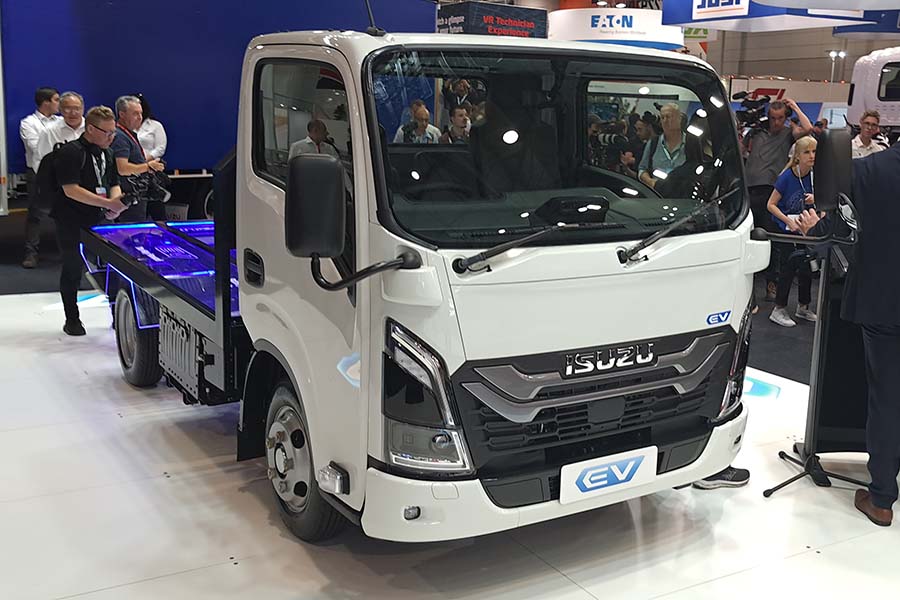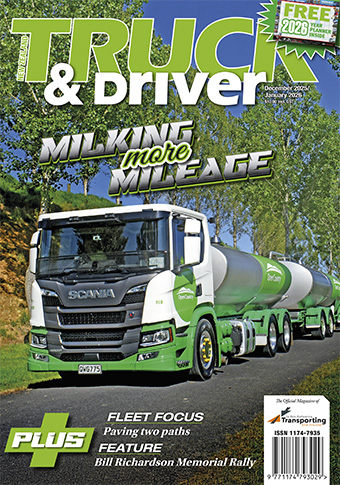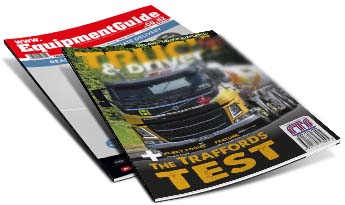Aeolus Truck & Driver News


Brisbane drives into the future
Aeolus Truck & Driver News
The 2023 Brisbane Truck Show opened its doors on May 18 just as this issue of New Zealand Truck & Driver magazine went to the printers.
The biennial industry event was back to its traditional levels of participation and international relevance after the 2021 edition was staged in the midst of Covid-19 disruptions.
Following the theme of other international shows, the focus was primarily on electric, and hydrogen fuelled transport – both light-duty and heavy trucks.
Notable debuts included Isuzu’s new battery electric N Series and the next gen Fuso eCanter, both Japanese light-duty electric trucks making their first southern hemisphere appearances.
...The 2023 Brisbane Truck Show opened its doors on May 18 just as this issue of New Zealand Truck & Driver magazine went to the printers.
The biennial industry event was back to its traditional levels of participation and international relevance after the 2021 edition was staged in the midst of Covid-19 disruptions.
Following the theme of other international shows, the focus was primarily on electric, and hydrogen fuelled transport – both light-duty and heavy trucks.
Notable debuts included Isuzu’s new battery electric N Series and the next gen Fuso eCanter, both Japanese light-duty electric trucks making their first southern hemisphere appearances.
Also gaining a share of the battery electric spotlight were the DAF LF Electric and Iveco eDaily while Daimler Truck previewed its eActros and eEconic models, ahead of upcoming validation trials in Australia and New Zealand.
Kenworth grabbed the big hydrogen headlines with one of the T680 fuel cell electric trucks that feature Toyota developed FCEV technology and have been trialled in California.
New diesel trucks also had a notable presence with Iveco debuting the new T-Way that replaces the Trakker range and shares many of its features with the latest S-Way. Western Star had its new trio of X models on show.
In a quick turnaround from its global premiere in March, Isuzu Australia had a Japan market production version of the new N Series EV as the centrepiece of its Brisbane stand.
The battery-electric vehicle (BEV) model portfolio ranges from standard cab models of less than 3.5 tonnes in GVW to wide-cab models of up to 7.5 tonnes in GVW.
The battery system for the N Series EV is based on multiples of 20kWh battery packs. The standard-cab model houses two battery packs with 40kWh capacity while the high-cab has three battery packs with a 60kWh capacity. Wide-cab long wheelbase models have five battery packs with 100kWh capacity.
Before the June issue of New Zealand Truck & Driver went to press, Isuzu New Zealand offered the following comment regarding the battery electric N Series and its introduction to the local market.
“Isuzu Trucks NZ will be watching with interest as to how the electric N Series is received by show goers. We are always in communication with Japan regarding future product opportunities, but don’t have anything to announce specifically at the moment.”
The second generation Fuso eCanter offers many improvements over the original with multiple battery, chassis and cab options to suit a wider range of applications.
The introduction of an electric power take-off (PTO) opens up new possibilities, for the truck’s electric power to operate tipper bodies, cranes, or even a fridge body.
And the introduction of an eAxle, with the electric motor integrated with the rear axle, delivers considerable efficiency and packaging gains while eliminating the need for a driveshaft.
A newly-developed electric motor develops maximum output of 129kW and 430Nm while an ‘engine brake’ system can slow the truck while harvesting energy at the same time, with four stages of regeneration.
Iveco’s battery electric eDaily light-duty model has made its `down under’ debut ahead of an evaluation programme starting soon in Australia.
The eDaily is the electrified version of the Daily, and will be the first Iveco BEV to be sold in the Australia and New Zealand markets.
The unit shown in Brisbane is a 70C cab chassis with 4350mm wheelbase, 7.2t GVM and three batteries. It’s one of several models that will be tested locally in preparation for roll-out of the broader eDaily line-up.
In other markets, the eDaily line-up is available in several van and cab chassis variants and with one, two or three batteries depending on configuration. At the top-of-the-range there is a combined battery capacity of 111kWh paired with an electric motor producing 140kW of power and peak torque of 400Nm. The loaded operating range will be up to 300km depending on model.
“The eDaily is a key element of Iveco’s product development strategy and transition roadmap as it pursues its decarbonisation targets through a multi-energy approach that includes a strong focus on electric propulsion,” says Michael May, Iveco ANZ Managing Director.
“The Iveco eDaily is already showing strong acceptance in Europe where it’s ideal for congested city environments; we believe it will also excel in these conditions locally, particularly in back-to-base operations.”
Being based on the conventional Daily range means existing eDaily owners will be familiar with the vehicle’s features and benefits. It’s a similar case for bodybuilders – all the main electric components sit within the conventional chassis with no protruding parts, and the chassis itself carries the exact same body mounting positions as the diesel product, to simplify body fitment.
The new Western Star 47X, 48X, and 49X were showcased on the Penske Australia stand.
The 47X has a short, sloped bonnet to yield payload flexibility, a set-back front axle, up to 72.5 tonnes GCM, and comes in either a 6x4 or 8x4 configuration with the choice of Cummins or Detroit powerplants.
Billed as `Exclusive to the Australian market’, the 48X is powered by the Detroit DD13 Gen 5 or DD16 engine. It’s available in 130-tonne GCM and features a set-forward front axle plus a choice of four sleeper cabs.
The 49X is powered by the Detroit DD16, has 200+ tonnes GCM capability, and is available with multiple cab options, including the 72-inch Stratosphere sleeper.
The X-Series was unveiled at the end of 2022 and has so far been on an Australian road show preview for dealers and both existing and potential customers.
“Across the series, we are offering the 330-380hp Cummins L9, 450-525hp Detroit DD13 Gen 5, and 500-600hp DD16 engines,” says Kurt Dein, head of Western Star Trucks, Penske Australia.
“Customers also have the choice of the Detroit DT12, Allison fully automatic, and Eaton Fuller manual transmissions.”
The new X-Series is billed as lighter, safer, stronger, and offers more cab space than any previous Western Star with benefits including premium noise and temperature insulation and triple door seals.
PACCAR grabbed attention with two zero-emission solutions – a hydrogen fuel cell Kenworth and a battery-electric DAF LF.
The Kenworth T680 hydrogen fuel cell electric vehicle is equipped with a 630hp electric motor and with 60kg of hydrogen gas stored at 700-bar there is enough energy for a range of 480km, with a 15-minute refuelling time.
The 19-tonne DAF LF Electric is a zero-emissions distribution truck with 260kW electric motor equipped with a 282kWh battery pack capable of a range of up to 280km.
One major truck brand had a conspicuous absence from the show, with Scania opting not to participate in 2023.
Full coverage of the 2023 Brisbane Truck Show will appear in the July issue of New Zealand Truck & Driver.



 + EQUIPMENT GUIDE - FREE
+ EQUIPMENT GUIDE - FREE
